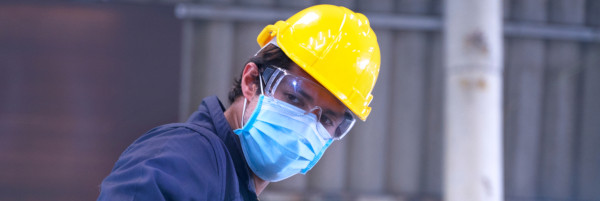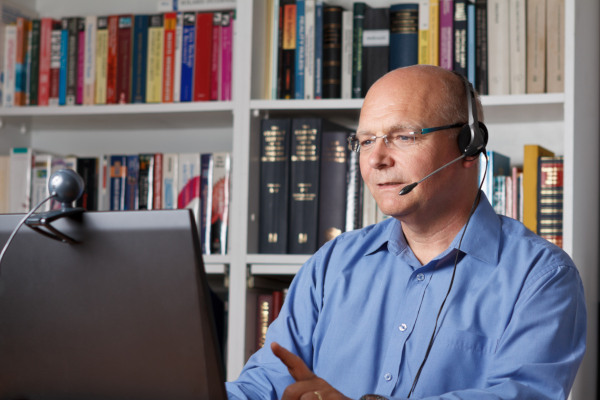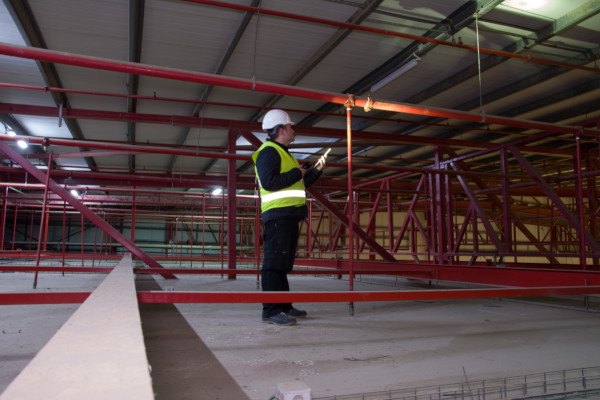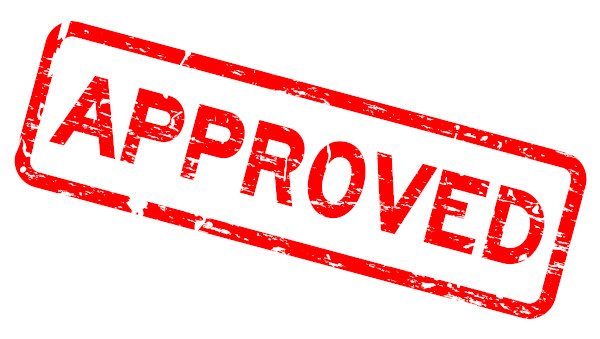Returning to Work After Covid-19: A Guide for Fire Sprinkler Contractors, Part 2

Read our actionable tips for fire sprinkler contractors and AHJs as businesses reopen
Despite the pandemic threat, protecting people and property from fire remains essential. Government mandates state that people who work in critical infrastructure industries—including fire sprinkler contractors—“have a special responsibility to maintain [their] normal work schedule.”
But many sprinkler professionals are understandably concerned about protecting themselves from COVID-19 exposure when visiting facilities—or exposing others if technicians don’t realize they are ill. And as restrictions start to ease, many are looking for ways to get back to work safely.
In Part 1 of our series on Returning to Work After COVID-19, we highlighted NFSA efforts to help fire sprinkler contractors hit the ground running as businesses reopen. We also emphasized novel opportunities that may arise in the new reality shaped by coronavirus.
In this installment, we look at the role technology can play in safe and effective fire sprinkler inspection, testing, and maintenance (ITM) during the pandemic. We also offer actionable tips for fire sprinkler contractors and authorities having jurisdiction (AHJs) as they get back to work.
Technology can enhance safety for fire sprinkler contractors until a coronavirus vaccine is released
In some instances, technology may hold the key to helping fire sprinkler contractors safely navigate the post-pandemic landscape—while also increasing efficiency, compliance, and consistency for sprinkler ITM. The fire protection industry is sometimes slow to embrace new technologies, but the National Fire Sprinkler Association (NFSA) believes the need for safe work environments will foster faster acceptance.
Let’s examine some of the key innovations that can help provide safer workplaces for sprinkler contractors in a new COVID-19 reality:
Remote video inspections
Some sprinkler contractors and AHJs pivoted to remote video inspections (RVI) during COVID-19. And while RVIs have served as an effective short-term solution during the pandemic, they are also gaining greater acceptance as an accepted way of doing business in the sprinkler industry.
A recent survey by the International Code Council (ICC) found that 40% of building department respondents can’t perform electronic plan reviews, 30% can’t do electronic permitting, and more than 60% can’t manage remote inspections during the pandemic. But as social distancing requirements continue, more AHJs and sprinkler contractors are realizing the need to embrace virtual capabilities. These processes can not only improve efficiency but provide business continuity under extreme circumstances.
Remote video inspection uses inexpensive video technology like FaceTime, Skype, or Zoom to enable sprinkler contractors or AHJs to perform visual checks without visiting a property. Instead, the inspector initiates a video call with someone onsite and walks them through the inspection.

Remote video inspections enable inspectors to ensure critical life safety systems remain in working order when buildings are closed to reduce virus transmission.
When buildings are closed, or access is limited to flatten the curve of the pandemic, RVI can help ensure that critical building, life, and electrical safety systems remain in working order. Jurisdictions have also used RVI to continue permit work during the crisis.
The need for onsite inspectors will never disappear, of course. But many contractors and AHJs are citing the advantages of RVIs while advocating them as a durable part of their operating models. The benefits include increased productivity, easier re-inspections, and the ability to perform inspections at any time. As part of their pandemic response, NFPA and ICC offer guidance on performing remote video inspections successfully, and ICC is currently developing a new virtual and remote inspection standard.
Automated inspection and testing
Typically, verifying code compliance involves a human inspector working onsite to confirm that applicable rules are followed. But while the need for onsite inspectors remains, NFPA 25: Standard for the Inspection, Testing, and Maintenance of Water-Based Fire Protection Systems has permitted certain automated inspection and testing of sprinkler systems since 2017.
From the 2020 edition of NFPA 25
4.6.6.1 Automated inspection and testing procedures performed in accordance with the requirements in this standard shall be permitted to be used.
4.6.6.2* Automated inspection equipment that meets the intent of a required visual inspection shall be permitted to replace the visual inspection.
4.6.6.3 Automated testing equipment shall produce the same action required by this standard to test a device.
Many ITM tasks are suitable for automation—improving efficiency for sprinkler contractors and enabling them to perform some NFPA 25 activities offsite. In the modern era of smart, integrated devices and systems, there are many opportunities for inspectors to gather relevant information by reviewing data instead of physically witnessing a process or condition.
For instance, pressure transducers may report data to a panel instead of requiring an inspector to physically look at a gauge. The 2020 edition of NFPA 25 permits even more automation, including a new automated flow switch that reduces the time and cost associated with testing by simulating the flow of water.

Innovations like this automatic flow switch can increase compliance and efficiency while enabling ITM professionals to perform some work remotely.
Automated inspection and testing can increase efficiency by allowing inspectors to verify multiple conditions simultaneously. It can also ultimately make some ITM tasks easier and decrease travel time.
These processes may also enhance safety for facilities, making it simple to inspect and test system components more frequently—thus reducing the time that a problem goes unnoticed. Many automated tests will also trigger alerts if results fall outside acceptable limits, calling immediate attention to issues that need to be addressed.
Automation also removes unintended consequences from tests; for instance, simulated water flow eliminates the need to discharge water into a parking lot or introduce new, oxygenated water that can lead to corrosion in a system.
Finally, automated testing enables companies to ensure their technicians don’t overlook inspection steps with a verifiable electronic record instead of a checked box on a form.
The potential for more widespread acceptance of automation comes at a critical time for the fire protection industry, which is facing a looming shortage of skilled workers. As current contractors retire and fewer high school graduates enter the trades, businesses need to adapt to a deficit of skilled labor.
At any given time, ICCsafe.org shows listings for more than 300 code official jobs, LinkedIn has more than 500, and Indeed.com lists more than 3,000. Over the next 15 years, it’s not out of the question for the code enforcement industry to experience an 80% loss of skilled workers. The fire sprinkler industry can expect similar losses of skilled inspectors.
While some contractors and labor may find the automation trend worrisome, it is set to complement existing services, not replace them. And using it for some of the tasks that currently require a person could mitigate the impact of the labor shortage in the face of rising demand for fire protection systems.

Digital sprinkler inspections support social distancing by enabling contractors to handle paperwork and collect signatures electronically.
Digital inspections and reporting
Digital inspections represent the future of fire sprinkler ITM. They hold the potential to increase compliance in fire safety systems and make inspections easier and more widespread. They can also standardize ITM reporting, so it is simpler, more consistent, and more actionable.
In 2018, NFSA hosted two digital ITM reporting summits, exploring topics like cost, the impact on sprinkler businesses, the extent of services, and the potential for bringing fire protection systems closer to 100% compliance. NFSA partnered with the Automatic Fire Alarm Association (AFAA) and the National Association of Fire Equipment Distributors (NAFED) on a position statement for AHJs to consider when engaging or contracting with third-party software vendors for ITM reporting services. For more information on the position of NFSA, AFAA, and NAFED, check out this resource.
The benefits of exchanging paper and clipboards for digital inspection software can be plentiful for sprinkler contractors, offering improvements to efficiency, productivity, and compliance. It can also increase ROI by generating instant proposals to repair deficiencies, enabling technicians to get approvals while they are still in front of the client.
But during COVID-19, the biggest benefit of implementing digital inspection software may be the ability to handle paperwork electronically. Several software options are preloaded with the questions, codes, and standards an inspector needs to ensure compliance. They also put a property’s inspection history at technicians’ fingertips, eliminating the need to comb through previous files to spot concerning trends.
After the inspection or maintenance, the software can generate inspection reports and link the technician to the back-office team, which can then create additional proposals and schedules. These platforms also reduce the need for face-to-face contact with clients by making it easy to deliver proposals and collect signatures electronically.

Social distancing measures remain critical to prevent exposure to coronavirus as businesses slowly reopen.
Tips to help fire sprinkler contractors return to work safely after COVID-19
For the most part, ITM activities make it easy for contractors to follow the safe social distancing practices recommended by the Centers for Disease Control and Prevention (CDC). A sole service provider can handle most requirements, limiting the need for face-to-face interaction. When two individuals are required, such as during full-flow trip tests on dry sprinkler systems, technicians can almost always use two-way radios to complete the task. A drone/video team could also record results during off-hours and have a qualified inspector review them later.
For sprinkler installations, social distancing is more challenging, but there are many ways to help ensure safety. Contractors should minimize staffing at specific jobs and educate installers on social distancing protocols while they are in the field. They should also emphasize the need for workers to follow recommended practices for handwashing and the use of enhanced personal protective equipment (PPE), in addition to standard PPE for jobs.
Sprinkler contractors should review specific guidance from the Occupational Safety and Health Administration (OSHA) for job site safety in the construction industry during the pandemic.
Before any type of work starts, it’s wise for sprinkler professionals to call ahead to ask whether anyone who was recently at the site is sick or quarantined—and delay scheduled activities accordingly. Contractors and facility managers should also discuss details of the job in advance via phone, email, or text to minimize face-to-face contact. That way, they can come up with an approach that makes both parties comfortable.
Watch this video to hear NFSA President Shane Ray discuss the sprinkler industry’s commitment to creating safe workplaces during the COVID-19 pandemic:
Consider these precautions to help enhance safety at your projects:
- Review and adjust project schedules to allow for social distancing, including staggered work scheduling and extra shifts to physically separate employees working onsite.
- Develop a written virus response policy—and enforce it.
- Provide a process to recognize and remove sick employees from the rotation. Create policies that encourage workers to stay home if they are sick. Require anyone entering a work site to complete a health survey before entry. The CDC also offers guidelines for managing essential workers who are asymptomatic but have been exposed to the virus.
- Conduct job site safety briefings remotely.
- Work with owners and facility managers to ensure that essential ITM work continues, systems remain in service, and impairments are addressed immediately.
- Clean and sanitize all equipment and surfaces that workers touch at a facility. Encourage facility managers to perform additional sanitation. Coronavirus can live on sprinkler system surfaces like metal for up to 5 days, plastic for 2-3 days, and copper for about 4 hours.
- Review and comply with OSHA requirements to prevent employee exposure to the virus, including PPE standards requiring gloves, goggles or safety glasses, face protection, and respiratory protection.
- Provide procedures for proper disposal and removal of used cleaning supplies and personal protective equipment.
- Eliminate centralized gathering or eating areas, including coffee and lunch trucks. Encourage employees to bring their own food, drink, and utensils.
- Prepare contingency plans for a potential reduction in workforce, limited materials/supplies, or the need to suspend a job site for cleaning.

What AHJs can do to speed economic recovery while ensuring safety
Stakeholders in the fire protection community share a common goal: protecting buildings and occupants from fire. As the fire sprinkler industry moves toward recovery, there are many ways AHJs can help speed the process.
Some contractors have raised concerns that the backlog of permits in closed or short-staffed building departments could delay the sprinkler industry’s recovery. To address that issue, forward-thinking AHJs are expediting permits at locations where sprinkler work can immediately start over job sites that have yet to open.
NFSA is committed to supporting AHJs as the nation takes the first tentative steps toward a phased reopening plan. We encourage AHJs to contact our headquarters or their local NFSA field office to take advantage of our resources and technical expertise as they move forward with permitting, plan reviews, and inspections. We can help them understand the full impact of the current situation on our industry and ensure quality inspections continue during the pandemic.
NFSA smooths the way as fire sprinkler contractors get back to work
As the sprinkler industry emerges from the COVID-19 crisis, NFSA will continue to stand shoulder-to-shoulder with our members, offering the support you need to help your business prosper. Understanding the precautions that should be taken in this unprecedented environment—and the resources that are available to help—are essential for a safe return to work.
Please continue to monitor and follow recommendations from the World Health Organization (WHO), CDC, and OSHA, as well as guidance and orders from federal, state, and local governments. You can also keep an eye on NFSA’s COVID-19 response page for the latest developments that impact the sprinkler industry.
And, of course, our members should continue to reach out to NFSA via our website or by calling 443-863-4464 for answers and support as the world re-opens. Not an NFSA member? Join today!
For over a century, the National Fire Sprinkler Association (NFSA) has served as the voice of the fire sprinkler industry. Our mission: advocating to protect lives and property through the widespread acceptance of the fire sprinkler concept. To join NFSA or learn more about the ways membership can benefit your organization, visit nfsa.org/join.
